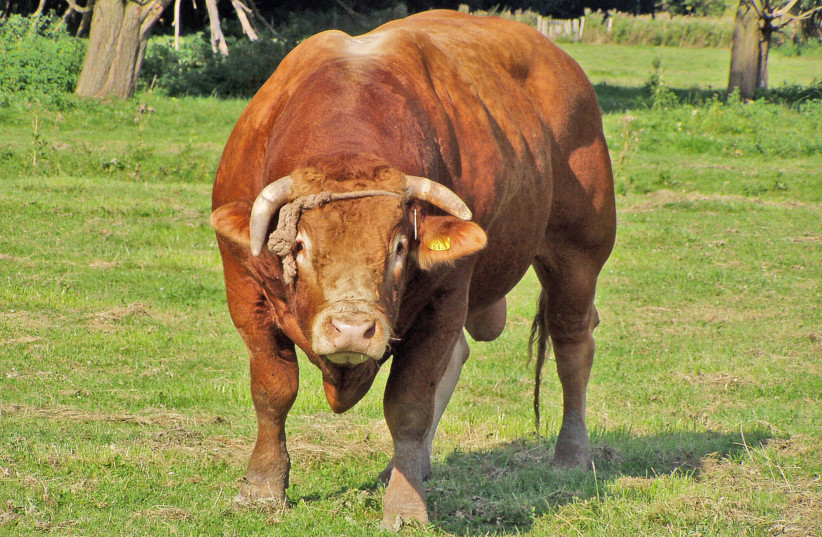It’s not only dogs, cats, and horses that make beneficial therapy animals for the sick, depressed, disabled, and elderly. Female and male cows can do it too, according to a new study carried out by scientists at New York University (NYU) and the US Military Academy at West Point in New York State.
The researchers also found that cows (or heifers, bulls, or steers) that are cuddled as therapy animals showed a strong preference for interactions with women when compared to men.
Koeknufflen is the Dutch term that translates directly to mean “cow cuddling” or “cow hugging.” In the Netherlands, there is a tradition of traveling from the cities to the countryside to spend time with farm animals in order to decompress and emotionally recalibrate
Green Chimneys, a New York State mental health facility for adolescents with mental illness is one of the few schools in the US that has successfully incorporated the “green care” (using farm animals for therapy for humans).

Greater attachment
The research published in the journal Human-Animal Interactions and entitled “Cow cuddling: cognitive considerations in bovine-assisted therapy,” opens a new era on whether some therapies may be initially stronger based upon gender and not procedure, highlighted that the women also reported greater attachment behaviors towards the steers.
Animal-assisted therapy (AAT) is an integrative model used in conjunction with other methods such as psychodynamic psychotherapy and cognitive behavioral therapy. The most common AAT model, the scientists said, is when a pet like a dog or cat is integrated into a therapeutic plan. This model has been studied with a variety of populations and conditions, from treating substance abuse to autism, often with positive results.
NYU Prof. Katherine Compitus and Prof. Sonya Bierbower at West Point conducted the research using the Human-Animal Interaction Scale – a 24-item self-report instrument designed to describe and quantify behaviors performed by humans and animals during an episode of interaction – as a measurement tool
The scientists examined the behavioral and cognitive traits of cattle that work as therapy animals. Special attention was paid to the welfare and enrichment benefits of cattle involved in bovine-assisted therapy. They believe that cows have special behavioral traits that allow them to bond with people in a way that is unique to their size and temperament.
Two steers named Magnus and Callum worked a total of 11 people – from youngsters aged 13 up to people aged 79. The authors said that until now, little research has investigated the therapeutic benefits of animal-assisted interventions with farm animals.
“We have discovered in the current study that bovine-assisted therapy may not be not only an effective treatment model that benefits people but appears to be enriching to the cattle as well, as shown by their proximity to and continuous interactions with humans,” said Compitus.
Organizations that certify therapy animals will sometimes certify several species of animals to work as a therapeutic partner, such as llamas, miniature horses, and rabbits. However, to date, there has been little research investigating the therapeutic benefits of farm animals.
The researchers suggested that cattle that are uncomfortable with a human presence will show an increase in stress signals such as vocalizations when involved in therapy work, while cattle that enjoy human company will have reduced stress signals.
Other notable behaviors in cattle during AAT may include lying down and licking or smelling the person. This is indicative of their comfort level with humans since cows are known to engage in social grooming.
With the two cattle in the study, the two scientists found that after 45 minutes of contact with the humans, Magnus and Callum often smelled or licked them and accepted food from them. They also allowed physical human-initiated interactions in the form of hugs, grooming, petting, or kisses. The animals rarely made unfriendly or aggressive gestures towards them, though they would occasionally decline to interact.
One participant stated that she was worried the bulls would be more aggressive but “fell in love with cows” after the session. All participants reported having an overall positive session with the steers and most stated they would recommend bovine assisted therapy to a friend.
“The results of this study show that the steers showed a strong preference or interactions with women compared to men, and, in turn, the women reported stronger attachment behaviors towards the steers,” Compitus said. “It’s unclear without further testing whether the animals sought out the attention of women in general or if the women were more likely to initiate the actions when compared to the men participants.”
The scientists conclude that they discovered in the study that bovine-assisted therapy may not only be an effective treatment model that benefits human participation but appears to be enriching to the cattle participants, as well, as shown by their proximity to and continuous interactions with humans.
